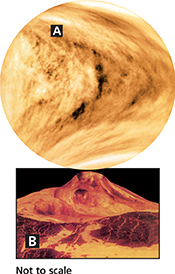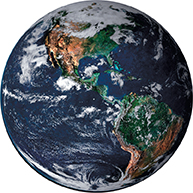Exploring Mercury
Because Mercury is so close to the sun, it's hard for astronomers on Earth to see. Images are taken by space probes, such as the Mariner and Messenger. As Figure 13 shows, the surface looks like that of Earth's moon. Numerous craters indicate that Mercury has been largely unchanged for billions of years. The Messenger space probe made three flybys of Mercury from 2008–2009, revealing a magnetic field, volcanism, and water ice within some of its craters.
Venus
Venus is called the “evening star” or “morning star” because it is only seen in the west after sunset or in the east before sunrise. With the exception of the moon, it is the brightest object in Earth's night sky. Venus's rotation is unusual in that it rotates in the direction opposite to which it revolves. The rotation rate is also very slow—Venus takes 243 days to rotate around its axis. Venus's day is longer than its year!
Venus's Atmosphere
Venus is difficult to study from space because clouds hide its surface, as shown in Figure 14A. Venus's atmosphere is so thick that the pressure at its surface is 90 times that on Earth.  Venus's thick atmosphere is composed mostly of carbon dioxide, which traps heat and raises the planet's temperature. Venus's atmosphere also contains droplets of sulfuric acid. Spacecraft that landed on Venus's surface in the 1970s found the average surface temperature to be 460°C. Any water that may have once existed on Venus has long since boiled away.
Venus's thick atmosphere is composed mostly of carbon dioxide, which traps heat and raises the planet's temperature. Venus's atmosphere also contains droplets of sulfuric acid. Spacecraft that landed on Venus's surface in the 1970s found the average surface temperature to be 460°C. Any water that may have once existed on Venus has long since boiled away.
Exploring Venus
The high sulfur content of Venus's atmosphere probably results from numerous volcanoes, like the one shown in Figure 14B. The outpouring of lava from volcanoes has frequently resurfaced the planet, erasing craters as well. As a result, Venus's surface has only a small number of impact craters. Though Venus probably has active volcanoes, it shows no evidence of plate tectonics.
Earth
When you compare Earth to the other terrestrial planets using the data in Figure 12, Earth does not seem unusual. But Earth is unique in several important respects. Earth's surface has a suitable atmosphere and temperature range for water to exist as a liquid. The presence of liquid water makes Earth, shown in Figure 15, very different from the other planets. Water makes it possible for Earth to support millions of different species of living things. Water also causes erosion, which has shaped Earth's land surface in many ways.
Earth's surface has a suitable atmosphere and temperature range for water to exist as a liquid. The presence of liquid water makes Earth, shown in Figure 15, very different from the other planets. Water makes it possible for Earth to support millions of different species of living things. Water also causes erosion, which has shaped Earth's land surface in many ways.
Figure 14 Venus's surface is not visible from space because of its very thick atmosphere.
A Photographs in visible light only show Venus's clouds. B Radar is able to penetrate Venus's atmosphere. Radar data were used to produce this false-color image of a volcano on Venus. Formulating Hypotheses Why is Venus the brightest planet as seen from Earth?

Figure 15 Earth is unique among the planets in having liquid-water ocean at its surface.





